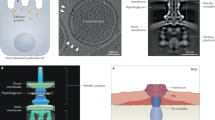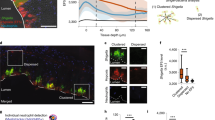Abstract
Salmonella enterica serotype Typhimurium (S. Typhimurium) causes acute gut inflammation by using its virulence factors to invade the intestinal epithelium and survive in mucosal macrophages. The inflammatory response enhances the transmission success of S. Typhimurium by promoting its outgrowth in the gut lumen through unknown mechanisms. Here we show that reactive oxygen species generated during inflammation react with endogenous, luminal sulphur compounds (thiosulphate) to form a new respiratory electron acceptor, tetrathionate. The genes conferring the ability to use tetrathionate as an electron acceptor produce a growth advantage for S. Typhimurium over the competing microbiota in the lumen of the inflamed gut. We conclude that S. Typhimurium virulence factors induce host-driven production of a new electron acceptor that allows the pathogen to use respiration to compete with fermenting gut microbes. Thus the ability to trigger intestinal inflammation is crucial for the biology of this diarrhoeal pathogen.
This is a preview of subscription content, access via your institution
Access options
Subscribe to this journal
Receive 51 print issues and online access
$199.00 per year
only $3.90 per issue
Buy this article
- Purchase on Springer Link
- Instant access to full article PDF
Prices may be subject to local taxes which are calculated during checkout




Similar content being viewed by others
References
Harris, J. C., Dupont, H. L. & Hornick, R. B. Fecal leukocytes in diarrheal illness. Ann. Intern. Med. 76, 697–703 (1972)
Santos, R. L. et al. Life in the inflamed intestine, Salmonella style. Trends Microbiol. 17, 498–506 (2009)
Stecher, B. et al. Salmonella enterica serovar Typhimurium exploits inflammation to compete with the intestinal microbiota. PLoS Biol. 5, 2177–2189 (2007)
Barman, M. et al. Enteric salmonellosis disrupts the microbial ecology of the murine gastrointestinal tract. Infect. Immun. 76, 907–915 (2008)
Sekirov, I. et al. Antibiotic-induced perturbations of the intestinal microbiota alter host susceptibility to enteric infection. Infect. Immun. 76, 4726–4736 (2008)
Lawley, T. D. et al. Host transmission of Salmonella enterica serovar Typhimurium is controlled by virulence factors and indigenous intestinal microbiota. Infect. Immun. 76, 403–416 (2008)
Muller, L. Un nouveau milieu d’enrichissement pour la recherche du bacille typhique at paratyphique. C. R. Seances Soc. Biol. Fil. 89, 434–437 (1923)
Hensel, M., Nikolaus, T. & Egelseer, C. Molecular and functional analysis indicates a mosaic structure of Salmonella pathogenicity island 2. Mol. Microbiol. 31, 489–498 (1999)
Hensel, M., Hinsley, A. P., Nikolaus, T., Sawers, G. & Berks, B. C. The genetic basis of tetrathionate respiration in Salmonella typhimurium . Mol. Microbiol. 32, 275–287 (1999)
Furne, J., Springfield, J., Koenig, T., DeMaster, E. & Levitt, M. D. Oxidation of hydrogen sulfide and methanethiol to thiosulfate by rat tissues: a specialized function of the colonic mucosa. Biochem. Pharmacol. 62, 255–259 (2001)
Levitt, M. D., Furne, J., Springfield, J., Suarez, F. & DeMaster, E. Detoxification of hydrogen sulfide and methanethiol in the cecal mucosa. J. Clin. Invest. 104, 1107–1114 (1999)
Hinsley, A. P. & Berks, B. C. Specificity of respiratory pathways involved in the reduction of sulfur compounds by Salmonella enterica . Microbiology 148, 3631–3638 (2002)
Reinders, C. A. et al. Rectal nitric oxide and fecal calprotectin in inflammatory bowel disease. Scand. J. Gastroenterol. 42, 1151–1157 (2007)
Barthel, M. et al. Pretreatment of mice with streptomycin provides a Salmonella enterica serovar Typhimurium colitis model that allows analysis of both pathogen and host. Infect. Immun. 71, 2839–2858 (2003)
Tsolis, R. M., Adams, L. G., Ficht, T. A. & Baumler, A. J. Contribution of Salmonella typhimurium virulence factors to diarrheal disease in calves. Infect. Immun. 67, 4879–4885 (1999)
Raffatellu, M. et al. Lipocalin-2 resistance confers an advantage to Salmonella enterica serotype Typhimurium for growth and survival in the inflamed intestine. Cell Host Microbe 5, 476–486 (2009)
Zhang, S. et al. SipA, SopA, SopB, SopD and SopE2 act in concert to induce diarrhea in calves infected with Salmonella enterica serotype Typhimurium. Infect. Immun. 70, 3843–3855 (2002)
Lupp, C. et al. Host-mediated inflammation disrupts the intestinal microbiota and promotes the overgrowth of Enterobacteriaceae. Cell Host Microbe 2, 119–129 (2007)
Thomson, N. R. et al. The complete genome sequence and comparative genome analysis of the high pathogenicity Yersinia enterocolitica strain 8081. PLoS Genet. 2, e206 (2006)
Acknowledgements
We thank H. Chu for providing real-time PCR primers, V. Tolstikov for performing the liquid chromatography–mass spectrometry analysis, M. Xavier for assistance with histopathology and V. Gerriets for technical assistance. Work in A.J.B.’s laboratory is supported by Public Health Service grants AI040124, AI044170, AI073120, AI076246 and AI088122. P.T. was supported by a stipend from the Department of Microbiology, Chiang Mai University, Thailand.
Author information
Authors and Affiliations
Contributions
S.E.W. contributed to the experimental design, constructed bacterial strains and contributed to Figs 1c–e, 2c, d, 3d, e and Supplementary Figs 1a, b, e, f and 3. P.T. contributed to Fig. 1f and Supplementary Fig. 1c, d and assisted with mouse experiments. M.G.W. assisted with mouse experiments and performed cloning experiments. B.P.B. contributed to Figs 1b , 2a, b, 3b, c and Supplementary Fig. 2. D.L.H. constructed bacterial strains. R.W.C. and J.M.R. contributed to Fig. 3a. L.G.A. performed the ligated loop surgery. C.L.B., L.G.A., R.M.T., J.R.R. and A.J.B. provided financial support for the study and contributed to the experimental design. S.E.W. and A.J.B. were responsible for the overall study design and for writing the manuscript.
Corresponding author
Ethics declarations
Competing interests
The authors declare no competing financial interests.
Supplementary information
Supplementary Information
This file contains Supplementary Figures 1-3 with legends, Supplementary Methods, Supplementary Tables 1-2 and additional references. (PDF 334 kb)
Rights and permissions
About this article
Cite this article
Winter, S., Thiennimitr, P., Winter, M. et al. Gut inflammation provides a respiratory electron acceptor for Salmonella. Nature 467, 426–429 (2010). https://doi.org/10.1038/nature09415
Received:
Accepted:
Issue Date:
DOI: https://doi.org/10.1038/nature09415
This article is cited by
-
Integrated analysis of gut metabolome, microbiome, and exfoliome data in an equine model of intestinal injury
Microbiome (2024)
-
Exposing new taxonomic variation with inflammation — a murine model-specific genome database for gut microbiome researchers
Microbiome (2023)
-
Engineered live bacteria as disease detection and diagnosis tools
Journal of Biological Engineering (2023)
-
Dietary supplemental coated essential oils and organic acids mixture improves growth performance and gut health along with reduces Salmonella load of broiler chickens infected with Salmonella Enteritidis
Journal of Animal Science and Biotechnology (2023)
-
Salmonella enterica serovars in absence of ttrA and pduA genes enhance the cell immune response during chick infections
Scientific Reports (2023)
Comments
By submitting a comment you agree to abide by our Terms and Community Guidelines. If you find something abusive or that does not comply with our terms or guidelines please flag it as inappropriate.



